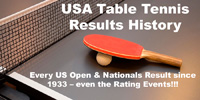Serve practice is my favorite practice. You want to know why? Because I know most of my opponents don’t practice their serves as much as I do (or used to, anyway), and so I will always have an edge on them!
The most important aspects of serve practice is to develop high-level serves that match your game, or the game that you want to play. (Note the difference there.)
Imagine your game, either as it is now or as you want it to be. What serves would you want to develop for that game? If you are a standard attacker, then you want serves that set up your attack. Some want opponents to push their serves back long so they can loop (forehand or backhand), and so do a lot of backspin serves, with other spins mixed in. (Mixing up short and very low backspin and no-spin serves are especially effective.) Others might want soft topspin returns, and so may serve more sidespin or side-top, and may also focus on half-long serves, where the second bounce, given a chance, would be right at the opponent’s end-line. Or you might want to focus on deep serves, such as big breaking sidespin serves. (This doesn’t work as well at the higher levels where they are usually attacked, but are effective as a variation.)
Besides your standard serves that set you up, what surprise serves should you develop that will both give you perhaps a few free points as well as make the opponent guard against those serves, thereby making your other serves more effective?
Perhaps have a coach or high-level player take a look at your serves, or show you his. Then practice and develop your serves to the highest level you can. Here’s a hint – you may never move or stroke at the pace and consistency of a world-class player, but there’s NOTHING that keeps you from developing world-class serves.
Here’s my tip, Practicing Serves the Productive Way.





